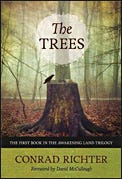The Trees is the first in a trilogy about the transformation of the American landscape as settlers moved westward. Sayward Luckett is fifteen as The Trees begins, her family following her itchy-footed father into unsettled country. Reaching the crest of a ridge, they find a view spread out below: "It was a sea of solid tree-tops broken only by some gash where deep beneath the foliage an unknown stream made its way. As far as the eye could reach, this lonely forest sea rolled on and on till its faint blue billows broke against an incredibly distant horizon.... Sayward saw her mother's eyes search with the hope of finding some settlement or leastwise a settler's clearing. But over that vasty solitude no wisp of smoke arose."
As Sayward and her family descend and begin making a home of sorts, Richter brings readers right into the woods with them. We feel the father's restless energy as he erects log walls at a frenzied pace and then, roofless cabin half finished, trades axe for rifle and disappears into the trees to return at dusk, day after day, with "a skin or two wrapped around the choicest parts of the carcass." We feel the ailing mother's despair. "She had had her say and what good did it do her? The time to have set herself against this place was away back in the old state..." We feel the children's delight, swinging on vines "back and forward over logs that would have broken their backs had they ever let go."
Weathering hardship and tragedy, Sayward learns a taciturn, compassionate wisdom. As other settlers filter into the area, she changes and the land changes. Lush in description, spare in judgment, Richter leaves us room to mourn the passing of the American wilderness even as we sympathize with the pioneer women's ache for civilization and its comforts - family and friends most of all. (1940; 154-175 pages in various editions)




